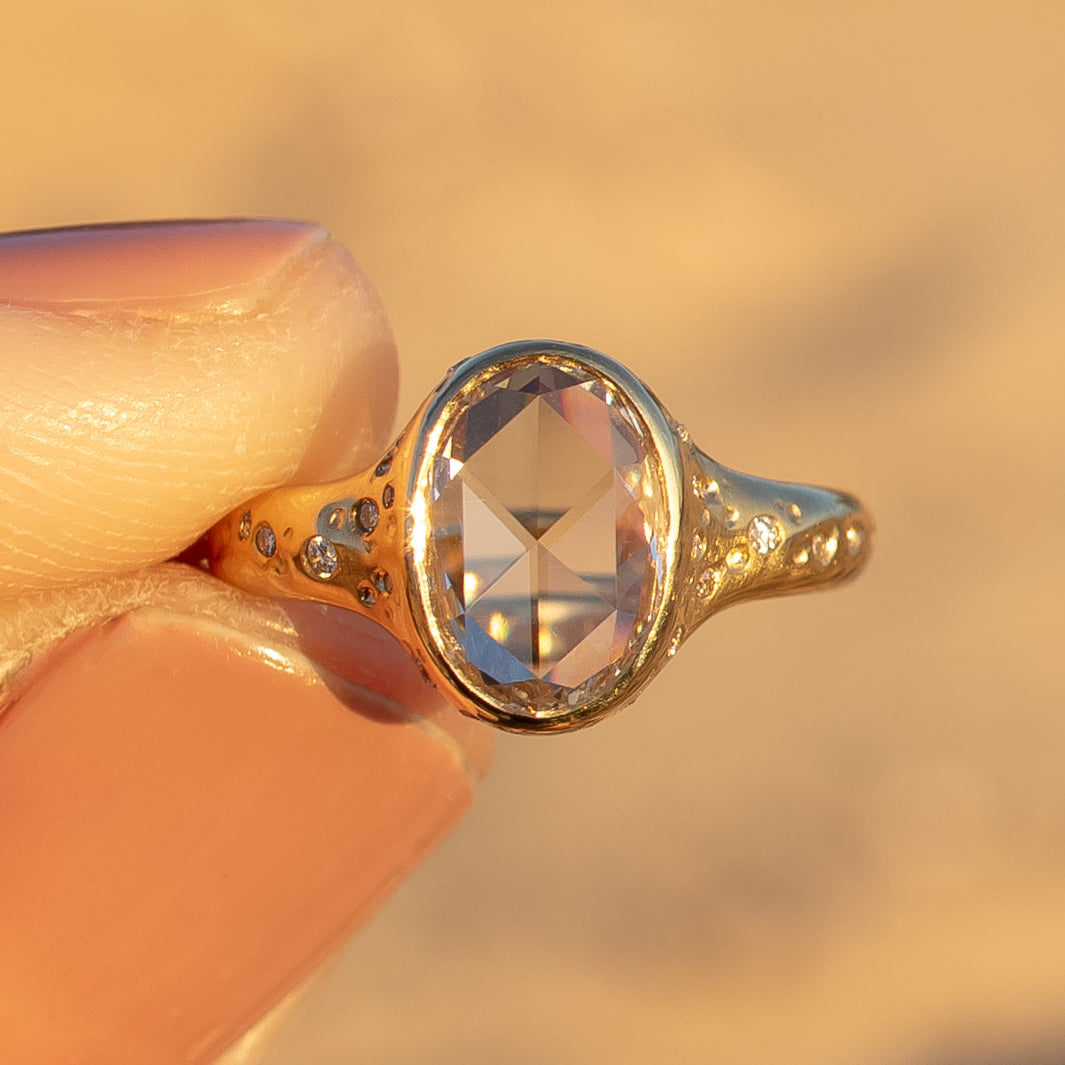The Rose Cut Gemstone Throughout History

Throughout history, gemstones have been treasured not only for their natural beauty but also for their symbolic meanings and captivating allure. Among the many ways these stones have been cut to enhance their brilliance, the rose cut stands out as one of the most historically significant and visually striking styles. Known for its unique, delicate form, the rose cut has a fascinating legacy that spans centuries and continues to influence contemporary jewelry design.
The rose cut is a specific style of gemstone cutting characterized by a flat base and a faceted dome-shaped top, resembling the petals of a rose in bloom. Unlike the modern round brilliant cut, which has a full depth to maximize brilliance and sparkle, the rose cut is shallow and broad, often with anywhere from 3 to 24 facets. The result is a soft, shimmering glow rather than a sharp, flashy sparkle, making it particularly ideal for vintage and antique jewelry designs.

The rose cut's origins date back to the 16th century, during the Renaissance period. As gemstone cutting techniques evolved, jewelers began experimenting with various ways to enhance the beauty of stones, and the rose cut emerged as a way to show off the color and clarity of gemstones without sacrificing their natural shape. The first rose cuts were typically used on diamonds and other precious stones, although it was later used for colored gemstones like sapphires, emeralds, and rubies.
By the 17th and 18th centuries, rose-cut diamonds became popular in Europe, particularly in French and English jewelry. The cut was favored for its ability to maximize the stone's surface area, giving it more visible size without compromising too much of its weight or intrinsic value. Rose cut diamonds were also more affordable than the newly emerging brilliant cut diamonds, which were still relatively rare and expensive due to the complexity of their cutting.
The rose cut reached its peak popularity during the Georgian (1714–1837) and Victorian (1837–1901) periods, where it was a staple in the creation of intricate and romantic jewelry designs. During these eras, diamonds were often set in antique jewelry pieces such as rings, brooches, and earrings, often in combination with colored gemstones like garnets, amethysts, and turquoise.

In the Georgian period, rose cut stones were often placed in closed-back settings, which concealed the back of the gemstone and created a soft, ethereal glow that was particularly sought after. The romantic and sentimental nature of the era's jewelry design lent itself well to the rose cut, as the understated elegance of the stones was in keeping with the period’s affinity for classical beauty.
During the Victorian era, the rose cut continued to thrive, particularly in the context of romantic jewelry. The cut was often used in engagement rings, as its soft sparkle and understated charm symbolized eternal love. As the Victorians adored personalization, rose-cut stones were also featured in lockets, cameos, and mourning jewelry, each piece imbued with deep emotional meaning.
After a period of decline in the early 1900s—when more modern cutting techniques like the brilliant and old European cuts came into fashion—the rose cut experienced a resurgence in the mid-20th century. Jewelry designers began looking back at historical cuts for inspiration, and the rose cut became a popular choice in vintage-style pieces and antique reproductions.
This revival was closely tied to the Art Deco movement, which reinterpreted antique aesthetics with a modern twist. Designers embraced the elegant, vintage charm of the rose cut, using it in both platinum and gold settings. The result was a blend of old-world grace with the sleek, geometric forms typical of the 1920s and 1930s.
Today, the rose cut is making a major comeback, particularly in the world of artisan and bespoke jewelry. Modern jewelers are rediscovering the rose cut for its ability to add a unique, romantic touch to their designs. Many contemporary designers favor rose cuts for engagement rings, cocktail rings, and one-of-a-kind statement pieces, as the cut offers an ethereal, vintage-inspired look that’s often more subdued and sophisticated than the high-glamour sparkle of modern brilliant-cut stones.
In addition to diamonds, rose-cut gemstones are now commonly seen in a range of other precious and semi-precious stones, such as sapphires, rubies, spinels, and even opals. The shallow depth of the rose cut allows for a wider array of stones to be used effectively, giving jewelers the freedom to experiment with different textures, colors, and effects.
One of the key reasons for the popularity of rose cuts today is the growing trend toward sustainable and ethical jewelry. Since rose-cut stones retain much of their natural size and shape, less material is wasted during the cutting process, making it a more environmentally friendly choice. Moreover, the cut's vintage aesthetic resonates with a growing interest in antique and heirloom-style jewelry, further fueling its revival.
There’s something undeniably captivating about the rose cut. Its understated elegance, combined with the soft play of light across its many facets, gives it a unique visual appeal that stands in contrast to the modern cuts that dominate today’s jewelry landscape. Whether used in a minimalist design or as the centerpiece of an elaborate vintage-inspired creation, rose-cut gemstones bring a touch of history and romance to any piece of jewelry.

From its origins in the Renaissance to its status as a modern design trend, the rose cut has proven that it is more than just a passing fad. It is a classic technique that continues to inspire and enchant, a testament to the enduring beauty and timeless appeal of finely crafted jewelry. So, the next time you’re on the hunt for a piece of jewelry that feels both elegant and timeless, consider the subtle sparkle of a rose-cut gemstone—it’s a cut that has stood the test of time and continues to capture hearts today.
|
Posted on December 04 2024

